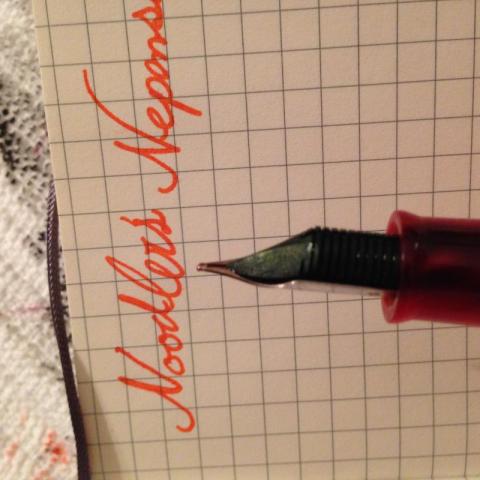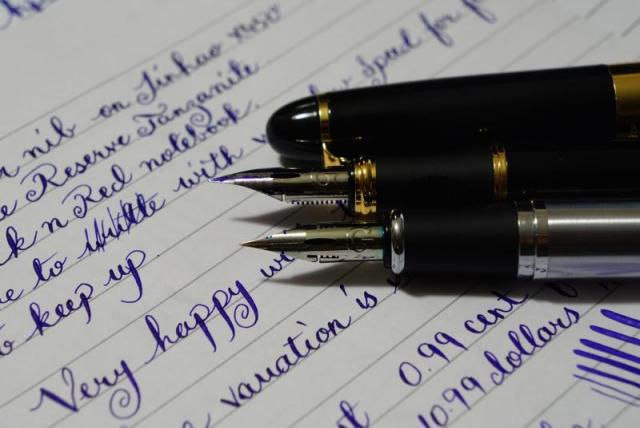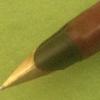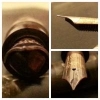Search the Community
Showing results for tags 'flex'.
-
I've got a couple of nice little vintage pens with flexible nibs, but I've long thought about a big, robust, modern pen with a flex nib. I mean a good one, not some cheesy something with steel or titanium sorta-flex. I know there are a few options. I have pondered. . . custom Edison with modified 14K flex nibGate City Belmont with modified 14K flex nibnew Wahl-Eversharp DECOBANDMy expectation is that the Belmont would be the least costly and not exactly elegant, but perhaps the most dependable, not having a sac or converter. The Wahl-Eversharp, obviously pricey and a thing of beauty to behold, but with a rubber sac that might somewhat limit my ink choices. The Edison, somewhere in between -- and it might be possible to get the nib from Edison for my Glenmont bulb-filler. But how do the nibs compare? Which is going to be the most pleasing to write with? That's the real goal here, after all.
- 18 replies
-
Hi all, I've been wanting to purchase a vintage flex pen for a while now, but can't seem to find any reputable places that sell them. Does anyone have any suggestions?
-
Here's what I spent my day doing, as a result of being salty about my Ackerman pump pen not arriving and getting no responses to my multiple queries to customer service. And really, it was so stupid-easy, I should have just done this to begin with. Annnnnd here's a general run-down on how I did it: Close-up of the tape overfeed on the nib: Hopefully other tinkerers and those who desire, specifically (like me), to use G nibs in their pens, will find this helpful and interesting. I know I'm enjoying it! The only problem I've come across is that you CANNOT give the pen a little downward shake to prime the nib. It will spew a big ol' droplet or two. The way I would describe how to get the nib tip primed, should it run dry, is to do little "woodpecker taps" on a piece of scrap paper. Or if you're really careful (*cough*adventurous*cough*), light taps where you're going to start your line. This should be familiar to others who have put dip nibs in fountain pens before.
-
link to the video: https://www.instagram.com/p/BAbgYqNrwrR/ Recently, i stumbled across this video where someone uses a pen nib with excellent flex. The video creator said it was the Hiro 40 Nib, but there appears to be a modifier or so on top of the reservoir. What is it? Does it add flex? What does it do?
- 15 replies
-
- indentification
- flex
-
(and 1 more)
Tagged with:
-
Let me begin this post by admitting that I am no expert in handwriting, and that my own handwriting is nothing about which to be proud. That being said, I have observed that the attribute known as "flex" seems to have assumed something of the aspect of a Holy Grail in penmanship. Certainly, I mean no offense to those who value this attribute; and certainly, in the hands of expert penmen, the ability to utilize expressive variance in line thickness evokes my profound admiration: but my worship of flex is tempered by the following considerations: 1) I have read stories of modern and antique nibs being destroyed in the attempt to achieve line-thickness variation. 2) I have seen nineteenth-century and early twentieth-century examples of utilitarian handwriting--business and personal letters and such--that show considerably less flex than one typically finds in latter-day attempts to achieve this quality with a fountain pen. 3) Based on my observations under 2), as well as my own handwriting, and that of members of my family's older generation, it is my impression that, except for calligraphy and the most exalted examples of Spencerian handwriting, flex is something that usually happens naturally, without much conscious effort on the part of the penman. Even most modern rigid-nibbed fountain pens produce a natural and subtle line variation which, while far short of Spencerian standards, is nonetheless most attractive and expressive. 4) As one who regards the fountain pen as a useful tool, as well as a thing of beauty in its own right, I am personally most interested in pens that can write rapidly and easily on a variety of papers, and which are robust enough to survive in a utilitarian environment. It is my understanding, based in part on personal experience, that the more flexible nibs tend to be harder to manage, slower, and more fussy in regard to paper. It is also my understanding that the general trend of fountain pen nibs since the 1920s has been towards rigidity, reliability, and durability--for our forebears did not regard the fountain pen as an exotic trophy, but, rather, as a practical writing instrument, as we regard the computer today. 5) My father had an incredibly beautiful handwriting; but even though he used to reminisce about the eyedropper-filled Waterman's fountain pen that he owned as a boy, which, he related, was capable of great variation in line thickness, his own handwriting, with both fountain pens and ball-point pens, showed no more than the subtle variations in thickness of line to which I have already referred. Beauty and elegance in penmanship does not necessarily require flexibility in the thickness of the line. 6) When I learned penmanship in the early 1950s, using dip pens and inkwells recessed in screwed-to-the-floor desks, my teachers said nothing about variations in line thickness as a criterion of good handwriting--even though they apparently covered everything else, and drove me half-crazy with their punctiliousness. As regards the whole matter of "flex," I am reminded of the exaggerated messa di voce that was much in fashion amongst early-music musicians in the 1970s. Although loosely based upon the writings of Quantz and other 18th-century theorists, their execution of this adornment transcended the boundaries of good taste and belonged--like so much that they did (and still do, alas) to the realm of mannerism. Without, once again, impugning those who rightly cultivate the beautiful and expressive art of flexibility of line variation, I am sensible of the need to beware of being more orthodox than the ancients themselves in this respect.
- 43 replies
-
- handwriting
- penmanship
-
(and 4 more)
Tagged with:
-
I have a flex nib who don't want to write smoothly. I've examined the tip and everything seems to be alright in fact of alignment. The only thing i can think about is the sharpness of the inner part of the tines.. Is This a common behaviour? How i can fix the problem?
-

The Eternal Nib...a Nail?
sidthecat posted a topic in Mabie Todd Research/Special Interest Forum/Group
Do Eternal nibs have any flex? I've never had the opportunity to try one.- 11 replies
-
- mabie todd
- eternal
-
(and 2 more)
Tagged with:
-
I've had my Neponset for a while now and the thing that's always bugged me is that the middle tine sits slightly above the outside tines when you aren't flexing the nib. This is the only music nib that I have ever used, so im not sure if this is normal. Any advice or insight into the following would be greatly appreciated.... I have experienced times when one of the outside tines will get caught underneath the middle tine. It's usually only happens when I'm writing/drawing on a really scratchy piece of paper. I've always assumed it was because the outside tine was getting caught on the paper and would pop underneath the middle because the tines bend towards each other. I was thinking about it tonight and it seems like when I flex the nib I feel, and I swear I hear (creaking), the tines rubbing against one another. So it seems like they would easily get twisted like I've described when flexing. I own two Ahab's so I don't feel like I put any inappropriate pressure on the Vishnu nib while flexing; I really don't think I've sprung the nib. In fact I thought this was how they are supposed to look( at least the Noodler's music Nibs). I'm on my second because the first wouldn't write at all because of a feed and section issue, and the nibs are identical. So it at least appears as though this is an intentional design. So, just a few questions: 1) is this normal for a Neponset? 2) is this common to music nibs? 3) will it permanently damage the nib if the outside tine pops under the middle tine? 4) is there a way to fix this?
-
Hi all! I'm not sure if there's already a post regarding this subject but I'm interested in delving into flex pens. What's the best way to approach it? Should I get a brand new pen that has a flex nib? If so, what are some examples that are sub-$100 USD? Or should I get a non-flex pen and swap it for a flex nib? If so, what options do I have that aren't incredibly scratchy. I actually own the Zebra Comic G nibs. Or should I get a vintage flex pen? I'm less sure how to make an educated choice or where to get one. Any advice would be appreciated. Happy writing and Happy New Year!
-
I was wondering about super flex nibs so i both a pack of G nibs and tried it on my Jinhao x450 and x740 and i must say i was quite surprised with the results, i am attaching a scanned page and a picture of the pens, the feed did keep up, but if you write fast than i am sure the feed will have trouble. i must say that once installed it is very very hard to get it out. i have used black n red notebook paper, which for me is really really good, it is as good as rhodia.
-
So... This is an other flex suggestion thread. Christmas shopping edition. I really need help choosing a fountain pen with a flexible nib (Yes, vintage pens are great but considering that near me there is no one to repair the pen if a problem occurs and the fact that parts are not very easily found, I do not want to go Vintage. Besides, taking a fountain pen out of the box with its warranty is ecstasy.) I have successfully "narrowed" my choices down to these. Of course, I am looking for suggestions on the topic. My budget would be about 200$. Pilot 912 FA nibDesiderata Flex Pen with a Zebra G nib and a Nemosine nib (extra, about 10 dollars)But, here is what I have been thinking. The Desiderata pen offers dramatic line variation and the feed is made around the nib, ensuring that the feed will keep up with the nib even when flexed which is the purpose of the nib. Contrasting to that, the Pilot 912 nib from what I gathered is the same on all Pilot 912 nib choices. For example, the 912 with a Posting nib has the same feed as a Pilot 912 with a FA nib. Consequently, the FA nib requires more ample flow. I have seen that this can be achieved by removing the breather tube that is inside the feed. However, I have heard that this modification can make the pen write excessively wet, not write at all if at the process of taking out the breather tube something goes wrong (No replacements parts found so far in order to feel free to experiment on that) or allow the ink to flow out of the pen. I would love to be corrected, but I would also like to learn some facts about the feed. How can the breather tube be safely removed?How can the breather tube be safely inserted again?How does the pen write after the tube is removed?I have heard that cutting a part off of the breather tube is a possibility, but considering that this procedure is irreversible and that such small part can ruin one of the most flexible modern nibs as characterized by some, I would not be eager to attempt such modification. Same applied to deepening the channel of the feed (the feed is plastic and I have not found any seller that offers replacements). Considering the above, I believe I have found the pros and cons of each pen. Pilot 912: Extremely flexible fountain pen, tipped modern nib that does not need to be replaced. Comes new, straight out of the box.Can be used as a daily writer as the nib is characterized "smooth on paper".The feed can be modified for additional ink flowVery weak ink flow when flexing, even a little bit, not helping the nib achieve its full potentialNo spare partsDoes not come tested(!)Modifications can end up in tears.(!)Desiderata Flex Pen Probably the most flexible pen out-of-the-box.Feed is designed around the nib and its capabilitiesAdditional Nemosine nib choicesCan be fitted with a home made plastic nib to satisfy my greed for flexCan come tested (?)Can be fitted with a Brause Rose or other nibs (?)The nib requires care in order to prevent corrosionThe nib needs to be replaced after a particular amount of use(!) Not a daily writer as I would need to swap nibs whenever I want to write or flex as the Zebra G nib lacks tipping (!).I am aware that both pens serve a different purpose, but they are the only modern flex choices. Or are they not? I am open to suggestions .
-
Often times when I see wet noodle wahl's (or any wet noodles for that matter) they lay down too much ink to where when not flexed the toppling amounts of ink make any color of ink just look black and you get no shading/color variation. I heard somewhere that this is because the ink demand for wet noodle's is so much since they flex so easily they are flexed like 40-50% of the time so it needs a lot of ink burping out to keep up with that feed. This is why when you fully flex a wet noodle and write in big letters the ink looks perfectly fine, but once you begin normal writing without flex, since the letters are so small compared to how the wet noodles should be used, the is too much ink being gushed out. And if you try to reduce the amount of ink coming out of the pen to make the normal writing not too inky, the ink flow while flexing is hindered and you get railroading whenever you try to fully flex. Is this true? Ex. https://youtu.be/JsV5Gc8IcQo?t=6m16s
-
Since getting going with my fountain pen addiction I've bought various pens(Ahab, TWSBI Mini, Kawecos & vintage etc), most are used to draw and I've tried lots of nib types and use different pens/nibs depending on how I feel. My ideal nib has flex as it allows line variation and greater expression in my drawings, as yet no pen met my needs, a couple of vintage pen came close though. My latest acquisition was a Platinum #3776 Century with an SF nib, at best the nib is semi flex but it's a nice pen with a nice nib and great to draw with. After using the #3776 I started thinking about flex again, a while ago I tried fitting the FPR flex nib to my TWSBI Mini with some success, sadly the feed couldn't keep up with the nib so I scrapped the idea. I recently bought an ICE Sport with a BB nib which puts down lovely thick, wet lines but it's not a flex nib, so I wondered if the feed would cope with a flex nib. I dug out the FPR nib again to see if maybe it would fit the Kaweco feed..it didn't but with a little tweaking it might After 15-20 minutes with a small file I took 3-5mm off the back of the nib, the FPR nib is slightly square and the Kaweco is round so I had to bend the FPR nib to make it sit snugly on the feed, fitting to the section is a tad tighter but not too bad. Initially the pen wouldn't write but after trying a couple of inks I got it to write a little. Some more tweaking and pushing the nib & feed further into the section and I was amazed at the results. The pen lays a VERY wet line and doesn't miss a beat unless I move fast while fully flexing, the picture shows just how much line variation I can get Behold the pen itself, I might change the white section to the ICE orange one once I'm happy that the flex nib is working ok. I've still got to fine tune the tines with my loupe to smooth out the nib but that'll only take a couple of minutes, for around 30 minutes of tinkering I'm now the proud owner of a new Kaweco flex pen There's no reason why the nib and feed can't be fit into my other Kaweco pens so I'll probably try it in my AL Raw which would be my ideal pen. The FPR flex nibs are really cheap and with a dremmel the modification would take seconds to do, so any Kaweco pen and flex lovers get going
-
Following is the comparison of some papers i had. i have been looking for a cheap good writing paper (with no luck i must add). i guess the best paper is not cheap. anyways since i had some different papers i thought i should do a little comparison. using Noodlers Apache Sunset and Noodlers Black Swan in Australian Roses with Flex pen Black n Red Notebook. this was the second cheapest for me and i really love this notebook, it is same as rhodia dot pad in terms of quality. The cheapest notebook i have is the Fabriano (40 Sheets) for 2.99 from hobby lobby. was not able to find white paper in this type, but still very high quality HammerMill Glossy finish 32lb paper. i would not recommend it for fountain pen use. HP 24 lb Paper. i heard alot about this paper but for me it is kinda disappointing as it does not have that much sheening or shading. but still it is not as bad as the copier paper. Rhodia paper. i dont think i need to say anymore now the last one i had, i love this paper. cant remember the name but i do still have the packaging of this ream, i will look for it and post if later. but this is one of my fav paper, it is not smooth but the color on this paper pops and it is very very ink resistant.
-
- hp 24lb
- hammermill
-
(and 1 more)
Tagged with:
-
Hello everyone! I have been going through threads about flex but I really eed some reccomendations. I am much willing to buy a flexible nib fountain pen but I am not sure what would be quite right. So far I have considered: Pilot 912 FA nibPilot 743 FA nibWahl Everharp (vintage flex)Noodler's Ahab with modified feed and Zebra G nibBuut... I do know what would better fit my needs. I heard that the Pilot feeds can not keep up with the flexibility of the nib leading to railroading. Any truth to that?What Pilot pen is more flexible? (Feel free to suggest other pens as well )
-
I'll do a full review after I've had more time to use it but I wanted to share some of Shawn Newton's most recent work. Some of the pictures were taken by me, others by Shawn. Shawn's photos are being used with his permission. http://i.imgur.com/iwZMEoY.jpg A while back I had the idea of having Shawn make me a pen like the Hemingway except with solid 14k trim. Shawn was totally up for it and when he and his jeweler started making nibs, he asked if I wanted one. It was a risk - I was the first customer to buy one of these nibs so I had no idea how it would write. I trusted that Shawn would make sure I got nice writing pen. I wasn't disappointed. http://i.imgur.com/YkkJSi3.jpg All the metal (the nib, and all the trim) are all solid 14k gold. Writing sample http://i.imgur.com/kFL1jCV.jpg This is the coolest part: It writes just like a vintage flex nib. It even has the responsiveness of vintage flex and the tines close quickly after letting up on the pressure. Shawn Newton has an amazing thing to offer with these handmade nibs. The ink used in the writing sample is Iroshizuku Ku-jaku. I have a Romillo Essential #9 with a semi-flexible Fine nib coming in a few weeks - I'm really excited to get to compare the two handmade nibs to one another. http://i.imgur.com/rKQgZKV.jpg Here's a good look at the feed, which Shawn cut by hand out of ebonite. http://i.imgur.com/jYuCmf8.jpg Handmade Newton nib compared to a Bock nib on an Eboya Kyouka, medium-size. Comparison with other pens http://i.imgur.com/RZuiRej.jpg From top: Romillo Eo #9, Edison Pearl with Karanuri urushi, Shawn Newton custom, Eboya Kyouka - medium-size. http://i.imgur.com/tDIDOfq.jpg It's a true piston-filler. Shawn makes the piston-filling mechanisms in-house. Here you can see the blind cap unscrewed.
- 26 replies
-
- shawn newton
- flexible
- (and 4 more)
-
Hello--I'm thinking of buying a Pilot/Namiki Falcon Soft Fine after seeing several artists state their preference for it and seeing how it writes in video reviews. I am planning to use it mostly for sketching on smooth watercolor or mixed media paper, and would like to use it for writing as well if it's smooth enough. I'm debating whether to go for a stock Soft Fine or whether to splurge for added flex. I've tried looking for posts on this pen with added flex, but it looks like most people who get this pen customized go for the Spencerian customization by John Mottishaw with the needlepoint grind and added flex. However, I don't wish to have anything finer than Fine just because I prefer to have more smoothness than an even finer line. Plus, I'm not going to use this for special calligraphy writing. I've read that this pen is not a true semi-flex pen, but just has a bouncy nib with some personality to the line. This is fine, though I would like to vary the line once in awhile while drawing. So I'm also wondering if "flexing" this pen is fairly easy and not too awkward to do while drawing, or if there's too much of a risk of springing the nib if you're not drawing very slowly and carefully. Thanks for your input in advance.
- 29 replies
-
- customizations
- pilot
-
(and 3 more)
Tagged with:
-
I recently acquired an Imperial, touchdown filler, that seems to have some nice line variation. I've assumed all were "nails" but I'm pleasantly surprised. Has anyone heard of such a thing?
-
I'm really fond of the dip nibs especially my Brause No 141 . But I'm looking for a flex nib Fountain pen under Rupees 1000 . I have no qualms about the exterior design I rather hardly care about its age . But then I'm low on budget right now and wouldn't mind a bad looking pen I just want an Extra fine or fine tipped flex pen . I have checked the Lucknow stores the price they quoted me was over 25000 .I have high hopes from FPN.
- 8 replies
-
- flex
- copperplate
-
(and 1 more)
Tagged with:
-
Hello everyone! I was wondering if you have some suggestions for modern frankenpens (pens with parts from a different manufacturer). I currently have a Jinhao x450 with a Zebra G nib that has a huge amount of flex. However, I have terrible railroading problems. Any suggestions on other flexible frankenpens and ink "combos"?
-

Sending An Extraordinary Vintage Wet Noodle To Bock Nibs In Germany
Sach posted a topic in Of Nibs & Tines
Anyone thought of this before? I'm sure the guys at Bock would be the best people around (possibly some Japanese makers too) to make a decent attempt to replicate a vintage flex nib. From the metulergy to the design to tempering the metal if needed I'm sure they could do it if there was sufficient interest. Potentially, if an order is big enough and enough people comit to an order, I'm sure it's possible..! Interested to hear your thought! Sach -
We read a lot about gold nibs being more flexible, but a steel nib can be just as flexible as a gold nib, if it's thin. Flex: It's true that 18k gold metal is about half as stiff as steel. So for identical dimensions an 18k gold nib is about twice as flexible as steel. But dimensions are very important too. For a given metal, the nib stiffness is proportional to width multiplied times the cube of thickness. The cube here means than reducing thickness by only twenty percent will double the flexibility of the nib. In other words, a steel nib can have the same flex as a gold nib, if it's 20% thinner. Line width: Furthermore, why do you want flexibility in a nib? If your answer is to increase the line width when you press, we need to consider the arch of the nib. The amount of spread is influenced by the amount of arch. You can approximate the arch with angles as indicated by the dashed lines in this sketch. The greater the arch, the greater the angle and thus the greater the separation as the nib flexes. So, variable line width is determined by more than nib metal. Thickness and arch play a big role. Durability: Of course you want the nib to spring back to its original shape after you press down. In this regard thinner steel is a better choice than thicker gold. There is less danger of it taking a permanent bend. So while we associate gold with quality and value, it's not always the best metal for the job. Steel is obviously a better metal than gold for your car's springs. It can be better for your nibs too, when properly designed.
-
I broke down a Hero 616 the other day (In the most literal sense, seeing as the section cracked.) and I found that the nib unit is the same size as an Esterbrook Lithographic crows quill nib. I tried in an a couple Hero 616 feed/collector units, and the fit seems to vary just a bit, some were really snug, while others were were loose enough to fall out. The crowsquill is too long to have the feed reach it correctly, but removing about a cm off made it the right length. Use the existing Hero's nib to scale it. I used a fine hacksaw and cleaned it up with a diamond pad. The Hero, being a hooded nib does not allow the full flex offered by the Esterbrook, but its more then the Hero, and offers simple line variation. Obviously its an untipped nib, so it will wear out after a while, and you have to watch for rust, as the nib is in contact with the inked feed. Filling is a bit more of a struggle as well, as the breather hole is covered by the new nib. As the feed was not designed for the ink delivery needed, a wetter ink is helpful, I added a little vodka and a speck of soap to my ink to try it out, but made it too wet. Your mileage may vary, but no permanent modification needed, besides trimming the dip pen nib. Other crows quills might be a better or worse fit, or work better or worse.
- 5 replies
-
- hero
- crowsquill
-
(and 1 more)
Tagged with:
-
Okay, I need some expert help, please. FINALLY, I got myself a flex Mabie Todd. Now I'm having trouble figuring out what a 42 is. The imprint says (and shows)Swan, but the clip shows the patent date with no Swan. Is that correct??? Is the clip gold or gold filled? It sure is shiny. Is this a Swan or a Frankenpen and about when was this lovely made? I'm so excited!!
- 30 replies
-
- mabir todd
- bchr
-
(and 2 more)
Tagged with:
-
I was looking for a cheap fountain pen with interchangeable italic nibs for a friend who recently got into fountain pens when I saw a dip pen set with a nib that looks exactly like the Blue Pumpkin. The set was Copperplate & Shadow and I could use a few more nibs so here is my comparison between the Leonardt 40 and the Brause 361 Left: Brause 361 Right:Leonardt 40 As you can see, the Brause 361 is a bit longer while the Leonardt 40 is a bit fatter. Otherwise, their shape is nearly the same. Probably because of its fatter shape, the Leonardt 40 could flex a bit more than the Brause 361 but the Brause 361 holds a lot more ink than the Leonardt 40 does. (I took one dip, didn't wipe any ink of then wrote until the ink ran out for both of them) Sorry for the smudges































